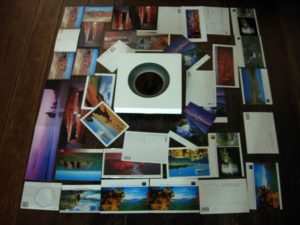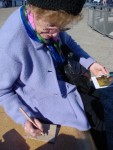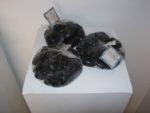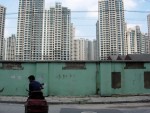Following advice provided by experts in Australia and China, Placing stones as they are found explores mining and globalism from the contradictory careful singular action of trying to “undo” the trajectory of a few small decorative Chinese stones. In a related journey from Uluru to the Australian coastline people discuss their connection to stone whilst drawing circles in the sand or on postcards depicting local natural stone features.
Gary Sangster writes:
“In early 2005, an elegant gesture of product repatriation was conceived and produced by Jenny Brown as a way of both describing certain elements of a working global economy and tracing the efficiency of a path of distribution. It was a modest act of economic anthropology that engaged research, performance, and documentation, as well as articulating an imagined or real cultural narrative of a concept of homeland and the actual journey of anonymous artifacts to their site of origin. The somewhat poignant, yet deeply ironic, pursuit of a homecoming, for near valueless materials or objects, small stones, garden decor-purchased inexpensively from a down-market, transnational department store in Sydney heightens the sense of disconnection and inauthenticity produced through a global economic marketplace. The project…suggests a sense of loss, or alienation, as objects of value, objects of use, objects of function, and objects of desire, large or small, voluble or mute, are interminably transferable, anonymously interchangeable, dislocated and redefined throughout the trade routes of mass-market capital. The work is an action of little consequence, a specific kind of elusive gesture of futility towards irreversible systems and processes, which makes sense only as a poetic or aesthetic form of art.”
The first of the three-part moving image work shows the Chinese stone journey and the second explores another trajectory involving people from Uluru to the Australian coastline discussing their connection to stone, whilst drawing circles in the sand or on postcards depicting local stone. Participants reported the way the circular mark-making gave a sense of satisfaction from the joy of bringing a line home; an unfulfilled desire in the work’s main chosen task given physical disruption to stones cannot be restored. Circles also link to ecological awareness that includes an Indigenous notion of time; pointing to a presence of ancestors in the past, present and future; where things happen simultaneously in these spaces and the future is foreshadowed in what is happening now. This is reflected in the three stone stories Indigenous academic Professor John Maynard shares for the work. Furthermore, through the connection between stone and bone, and stone and soul; the lost, stolen, repressed and disrupted connections with all of our ancestral traditions through migration, deportation and imperialism are implied, as well as Indigenous issues around repatriation and the erasure of sacred sites from mining.
The third screen depicting young men in traditional Chinese clothing, and older men in jeans and t-shirts carrying a stream of white goods up a staircase, draws in China’s use of our raw materials as a never-ending parade of manufactured white goods. Dressed-up with costume and performing pranks and gestures for the camera, it depicts the linearity and banality of modernity progress. As counterpoint, the soundtrack continues the work’s exploration of scale by presenting the sounds of hand-held technology hitting stone made by workers restoring a building for Suzhou’s only counter-culture company of this type.
This work was made as part of an Australia‐China Council residency, supported by National Association for the Visual Arts & NSW Ministry for the Arts in 2005. Documentation works were exhibited at “Views” BAU Gallery, Shanghai and Loose Projects, Sydney 2006.
Placing stones as they are found explores mining and globalism from the contradictory careful singular action of trying to “undo” the trajectory of a few small decorative Chinese stones. People in Australia and China working in various professions created my journey to many destinations in China that attempted to repatriate the stones to their original site. Gary Sangster writes:
 “In early 2005, an elegant gesture of product repatriation was conceived and produced by Jenny Brown as a way of both describing certain elements of a working global economy and tracing the efficiency of a path of distribution. It was a modest act of economic anthropology that engaged research, performance, and documentation, as well as articulating an imagined or real cultural narrative of a concept of homeland and the actual journey of anonymous artifacts to their site of origin. The somewhat poignant, yet deeply ironic, pursuit of a homecoming, for near valueless materials or objects, small stones, garden decor-purchased inexpensively from a down-market, transnational department store in Sydney-heightens the sense of disconnection and inauthenticity produced through a global economic marketplace. The project…suggests a sense of loss, or alienation, as objects of value, objects of use, objects of function, and objects of desire, large or small, voluble or mute, are interminably transferable, anonymously interchangeable, dislocated and redefined throughout the trade routes of mass-market capital. The work is an action of little consequence, a specific kind of elusive gesture of futility towards irreversible systems and processes, which makes sense only as a poetic or aesthetic form of art.”
“In early 2005, an elegant gesture of product repatriation was conceived and produced by Jenny Brown as a way of both describing certain elements of a working global economy and tracing the efficiency of a path of distribution. It was a modest act of economic anthropology that engaged research, performance, and documentation, as well as articulating an imagined or real cultural narrative of a concept of homeland and the actual journey of anonymous artifacts to their site of origin. The somewhat poignant, yet deeply ironic, pursuit of a homecoming, for near valueless materials or objects, small stones, garden decor-purchased inexpensively from a down-market, transnational department store in Sydney-heightens the sense of disconnection and inauthenticity produced through a global economic marketplace. The project…suggests a sense of loss, or alienation, as objects of value, objects of use, objects of function, and objects of desire, large or small, voluble or mute, are interminably transferable, anonymously interchangeable, dislocated and redefined throughout the trade routes of mass-market capital. The work is an action of little consequence, a specific kind of elusive gesture of futility towards irreversible systems and processes, which makes sense only as a poetic or aesthetic form of art.”
 Video documentation of the journey includes interviews with those who have set the search on different paths as well as another cultural narrative involving people from Uluru to the coastline drawing circles on the backs of scenic postcards of local stone, whilst discussing their connection to stone. The gesture draws attention to the flows of power in the globalised field of power that escape the reach of ordinary citizens and how specific efforts of resistance can move from entanglement to greater entanglement without providing political understanding. A more personal dimension of the work involves the way it touches on the connection between stone and bone, and stone and soul; the lost, stolen, repressed and disrupted connections with our ancestral traditions through migration, deportation and imperialism, as well as Indigenous issues around repatriation.
Video documentation of the journey includes interviews with those who have set the search on different paths as well as another cultural narrative involving people from Uluru to the coastline drawing circles on the backs of scenic postcards of local stone, whilst discussing their connection to stone. The gesture draws attention to the flows of power in the globalised field of power that escape the reach of ordinary citizens and how specific efforts of resistance can move from entanglement to greater entanglement without providing political understanding. A more personal dimension of the work involves the way it touches on the connection between stone and bone, and stone and soul; the lost, stolen, repressed and disrupted connections with our ancestral traditions through migration, deportation and imperialism, as well as Indigenous issues around repatriation.
Within the context of the work’s overarching focus on the displacement of stone as part of globalised manufacturing processes, the second moving image shows what to look at to see capitalism’s fundamental flaw. Older men in jeans and t-shirts alongside younger men in traditional Chinese clothes carrying boxes of consumer goods up stairs in an endless stream.
This work was made as part of an Australia‐China Council residency, supported by National Association for the Visual Arts and NSW Ministry for the Arts in 2005. Documentation works were exhibited at Casula Powerhouse, Mori Gallery and Loose Projects (Sydney), Gosford Regional Gallery and BAU Gallery, Shanghai 2006.



